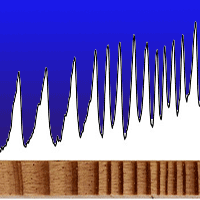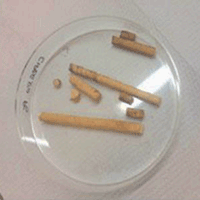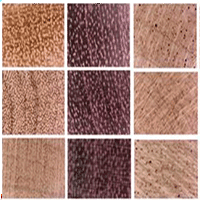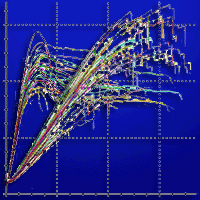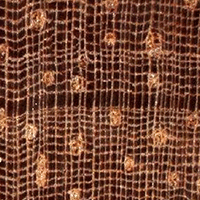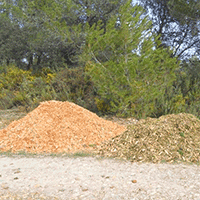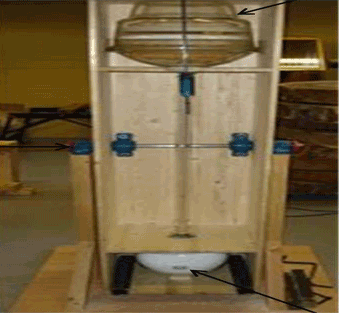
The potential of using xylarium wood samples for wood density calculations: a comparison of approaches for volume measurement
D Maniatis (1) , L Saint André (2-3), M Temmerman (4), Y Malhi (1), H Beeckman (5)
iForest - Biogeosciences and Forestry, Volume 4, Issue 4, Pages 150-159 (2011)
doi: https://doi.org/10.3832/ifor0575-004
Published: Aug 11, 2011 - Copyright © 2011 SISEF
Research Articles
Abstract
Wood specific gravity (WSG) is an important biometric variable for aboveground biomass calculations in tropical forests. Sampling a sufficient number of trees in remote tropical forests to represent the species and size distribution of a forest to generate information on WSG can be logistically challenging. Several thousands of wood samples exist in xylaria around the world that are easily accessible to researchers. We propose the use of wood samples held in xylaria as a valid and overlooked option. Due to the nature of xylarium samples, determining wood volume to calculate WSG presents several challenges. A description and assessment is provided of five different methods to measure wood sample volume: two solid displacement methods and three liquid displacement methods (hydrostatic methods). Two methods were specifically developed for this paper: the use of laboratory parafilm to wrap the wood samples for the hydrostatic method and two glass microbeads devices for the solid displacement method. We find that the hydrostatic method with samples not wrapped in laboratory parafilm is the most accurate and preferred method. The two methods developed for this study give close agreement with the preferred method (r 2 > 0.95). We show that volume can be estimated accurately for xylarium samples with the proposed methods. Additionally, the WSG for 53 species was measured using the preferred method. Significant differences exist between the WSG means of the measured species and the WSG means in an existing density database. Finally, for 4 genera in our dataset, the genus-level WSG average is representative of the species-level WSG average.
Keywords
Wood specific gravity, Aboveground biomass, Dry xylarium samples, Tropical forests, Congo basin forest
Authors’ Info
Authors’ address
Y Malhi
Environmental Change Institute, School of Geography and the Environment, Dyson Perrins Building, South Parks Road, OX1 3QY Oxford (UK)
CIRAD, UMR Eco & Sols, Ecologie Fonctionnelle, Biogéochimie des Sols & Agroécosystèmes, place Viala, F-34060 Montpellier (France)
INRA, UR BEF - Biogéochimie des Ecosystèmes Forestiers, F-54280, Champenoux (France)
Walloon Agricultural Research Centre (CRA-W), chaussée de Namur 146, B-5030 Gembloux (Belgium)
Laboratory for Wood Biology and Xylarium, Royal Museum for Central Africa, Leuvense Steenweg 13, B-3080 Tervuren (Belgium)
Corresponding author
Paper Info
Citation
Maniatis D, Saint André L, Temmerman M, Malhi Y, Beeckman H (2011). The potential of using xylarium wood samples for wood density calculations: a comparison of approaches for volume measurement. iForest 4: 150-159. - doi: 10.3832/ifor0575-004
Academic Editor
Marco Borghetti
Paper history
Received: Sep 15, 2010
Accepted: May 16, 2011
First online: Aug 11, 2011
Publication Date: Aug 11, 2011
Publication Time: 2.90 months
Copyright Information
© SISEF - The Italian Society of Silviculture and Forest Ecology 2011
Open Access
This article is distributed under the terms of the Creative Commons Attribution-Non Commercial 4.0 International (https://creativecommons.org/licenses/by-nc/4.0/), which permits unrestricted use, distribution, and reproduction in any medium, provided you give appropriate credit to the original author(s) and the source, provide a link to the Creative Commons license, and indicate if changes were made.
Web Metrics
Breakdown by View Type
Article Usage
Total Article Views: 63834
(from publication date up to now)
Breakdown by View Type
HTML Page Views: 52197
Abstract Page Views: 4804
PDF Downloads: 4953
Citation/Reference Downloads: 34
XML Downloads: 1846
Web Metrics
Days since publication: 5258
Overall contacts: 63834
Avg. contacts per week: 84.98
Citation Metrics
Article Citations
Article citations are based on data periodically collected from the Clarivate Web of Science web site
(last update: Mar 2025)
Total number of cites (since 2011): 17
Average cites per year: 1.13
Publication Metrics
by Dimensions ©
Articles citing this article
List of the papers citing this article based on CrossRef Cited-by.
References
Variation in wood density determines spatial patterns in Amazonian forest plots. Global Change Biology 10: 1-18.
CrossRef | Gscholar
Tree allometry and improved estimation of carbon stocks and balance in tropical forests. Oecologia 145 (1): 87-99.
CrossRef | Gscholar
Tropical deforestation as a source of greenhouse-gas emissions. In: “Tropical deforestation and climate change” (Moutinho P, Schwartzmann S eds). IPAM, Instituto de Pesquisa Ambiental da Amazônia, Belém, Pará, Brazil - Environmental Defense, Washington DC, USA.
Gscholar
Technologie des holzes und der holzwerkstoffe. Zweite auflage. I. Band. Springer-Verlag, Berlin - Göttingen, Heidelberg - Bergmann JF, München, pp. 1050.
Gscholar
Branch xylem density variations across the Amazon Basin. Biogeosciences 6 (4): 545-568.
CrossRef | Gscholar
Établissement des courbes de variation de la densité du bois par exploration densitométrique de radiographies d’échantillons prélevés à la tarière sur des arbres vivants - Applications dans les domaines technologique et physiologique. Ph.D. Dissertation, Université de Nancy-1, Champenoux, France, pp. 215.
Gscholar
Physical properties and moisture relations of wood. In: “Forest products laboratory. Wood handbook - wood as an engineering material. Gen. Tech. Rep. FPL-GTR-113, Forest Products Laboratory, USDA Forest Service, Madison, WI, USA, pp. 463.
Gscholar
Specific gravity, moisture content, and density relationships for wood. Gen. Tech. Rep. FPL-GTR-76, Forest Products Laboratory, USDA Forest Service, Madison, WI, USA, pp. 13.
Gscholar
Index xylariorum. Institutional wood collections of the World 3. IAWA Bulletin 9: 203-252.
Gscholar
Assessment of pine biomass density through mid-infrared spectroscopy and multivariate modeling. Bioresources 6: 807-822.
Gscholar
Wood variation: its causes and control. Springer-Verlag, Berlin, Germany.
Gscholar


